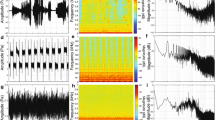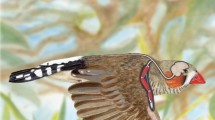Abstract
It is quite important for sensory processing to understand how feedback modulates the information processing in early brain areas in order to extract behaviorally-relevant features of stimulus. The auditory system of bats provides an ideal system for clarifying the mechanism of the adaptive processing by feedback. To investigate this mechanism, we developed a neural network model of bat’s auditory system for detecting Doppler-shifted frequency of sound echoes. Using the model, we demonstrate the receptive field modulation of cortical neurons and the modulation of the feedback to IC neurons, evoked by an electric stimulation and a GABA antagonist. Our model reproduces qualitatively the experimental results of best frequency (BF) shifts by Xiao and Suga (Proc Natl Acad Sci USA 99(24):15743–15748, 2002). We also show how the modulations cause the BF shifts of cortical and subcortical neurons. Furthermore we investigate the neuronal characteristics required for enhancing BF shifts.






Similar content being viewed by others
References
Anderson JS, Carandini M, Ferster DSJ, Car M, Orientation DF (2000) Orientation tuning of input conductance, excitation, and inhibition in cat primary visual cortex. J Neurophysiol 84:909–926
Ashida G, Carr CE (2011) Sound localization: Jeffress and beyond. Curr Opin Neurobiol 21(5):745–751
Bishop AL, Henson OW (1987) The efferent cochlear projections of the superior olivary complex in the mustached bat. Hear Res 31:175–182
Buonomano DV, Merzenich MM (1998) Cortical plasticity: from synapses to maps. Annu Rev Neurosci 21:149–186
Calford M (2002) Dynamic representational plasticity in sensory cortex. Neuroscience 111:709–738
Dayan P, Abbott LF (2005) Theoretical neuroscience: computational and mathematical modeling of neural systems. MIT Press, Cambridge
Feliciano M, Saldaña E, Mugnaini E (1995) Direct projections from the rat primary auditory neocortex to nucleus sagulum, paralemniscal regions, superior olivary complex and cochlear nuclei. Auditory Neurosci 1:287–308
Gaioni S, Riquimaroux HNS (1990) Biosonar behavior of mustached bats swung on a pendulum prior to cortical ablation. J Neurophysiol 64:1801–1817
Gao E, Suga N (1998) Experience-dependent corticofugal adjustment of midbrain frequency map in bat auditory system. Proc Natl Acad Sci U S A 95(21):12663–12670
Gao E, Suga N (2000) Experience-dependent plasticity in the auditory cortex and the inferior colliculus of bats: role of the corticofugal system. Proc Natl Acad Sci U S A 97:8081–8086
Goldman LJ, Henson OW Jr (1977) Prey recognition and selection by the constant frequency bat, pteronotus p. parnellii. Behav Ecol Sociobiol 2:411–419
Guillery R, Sherman S (2002) Thalamic relay functions and their role in corticocortical communication: generalizations from the visual system. Neuron 17:163–175
Guillery RW (1969) The organization of synaptic interconnections in the laminae of the dorsal lateral geniculate nucleus of the cat. Z Zellforsch Mikrosk Anat 96:1–38
Henson OW Jr, Henson MM, Kobler JB, Pollak GD (1980) The constant frequency component of the biosonar signals of the bat pteronotus parnellii parnellii. In: Busnel RG, Fish J (eds) Animal sonar systems. Plenum, New York, pp 913–916
Huffman R, Henson OJ (1990) The descending auditory pathway and acousticomotor systems: connections with the inferior colliculus. Brain Res Brain Res Rev 15:295–323
Izhikevich EM (2003) Simple model of spiking neurons. IEEE Trans Neural Netw 14:1569–1572
Kaas J (1991) Plasticity of sensory and motor maps in adult mammals. Annu Rev Neurosci 14:137–167
Kashimori Y, Inoue S, Kambara T (2001) A neural mechanism of hyperaccurate detection of phase advance and delay in the jamming avoidance response of weakly electric fish. Biol Cybern 85:117–131
Kelly JP, Wong D (1981) Laminar connections of the cat’s auditory cortex. Brain Res 212:1–15
Kisvárday ZF, Beaulieu C, Eysel U (1993) Network of GABAergic large basket cells in cat visual cortex (area 18): implication for lateral disinhibition. J Comp Neurol 327:398–415
Kleinfeld D, Berg RW, O’Connor SM (1999) Anatomical loops and their electrical dynamics in relation to whisking by rat. Somatosens Mot Res 16:69–88
Knudsen E, du Lac S, Esterly S (1987) Computational maps in the brain. Annu Rev Neurosci 10:41–65
Liu BH, Wu GK, Arbuckle R, Tao HW, Zhang LI (2007) Defining cortical frequency tuning with recurrent excitatory circuitry. Nat Neurosci 10:1594–1600
Liu XB, Honda CN, Jones EG (1995) Distribution of four types of synapse on physiologically identified relay neurons in the ventral posterior thalamic nucleus of the cat. J Comp Neurol 352:69–91
Markram H, Toled-Rodriguez M, Wang Y, Gupta A, Silberberg G, Wu C (2004) Interneurons of the neocortical inhibitory system. Nat Rev Neurosci 5:793–807
Nicolelis MAL, Fanselow EE (2002a) Dynamic shifting in thalamocortical processing during different behavioural states. Philos Trans R Soc Lond B Biol Sci 357:1753–1758
Nicolelis MAL, Fanselow EE (2002b) Thalamocortical [correction of thalamcortical] optimization of tactile processing according to behavioral state. Nat Neurosci 5:517–523
Rumelhart D, McClelland J (1986) Parallel distributed processing. MIT Press, Cambridge
Saldaña E, Feliciano M, Mugnaini E (1996) Distribution of descending projections from primary auditory neocortex to inferior colliculus mimics the topography of intracollicular projections. J Comp Neurol 371:15–40
Schnitzler H (1970) Echoortung bei der fledermacus chilonycteris rubiginosa. Z Verg Physiol 68:25–38
Sherman S, Guillery R (1996) Functional organization of thalamocortical relays. J Neurophysiol 37:1367–1395
Sherman SM, Guillery RW (2002) The role of the thalamus in the flow of information to the cortex. Philos Trans R Soc B 357:1695–1708
Sillito AM, Cudeiro J, Jones HE (2006) Always returning: feedback and sensory processing in visual cortex and thalamus. Trends Neurosci 29:307–316
Steriade M, Timofeev I (2003) Neuronal plasticity in thalamocortical networks during sleep and waking oscillations. Neuron 37:563–576
Suga N (1984) The extent to which biosonar information is represented in the bat auditory cortex. In: Edelman GM, Gall WE, Cowan WM (eds) Dynamic aspects of neocortical function. Wiley, New York, pp 315–373
Suga N (1990) Biosonar and neural computation in bats. Sci Am 262:60–68
Suga N, Ma X (2003) Multiparametric corticofugal modulation and plasticity in the auditory system. Nat Rev Neurosci 4:783–794
Trussell LO (1997) Cellular mechanisms for preservation of timing in central auditory pathways. Curr Opin Neurobiol 7:487–492
Vogels TP, Abbott LF (2009) Gating multiple signals through detailed balance of excitation and inhibition in spiking networks. Nat Neurosci 12:483–491
Xiao Z, Suga N (2002) Reorganization of the cochleotopic map in the bat’s auditory system by inhibition. Proc Natl Acad Sci USA 99(24):15743–15748
Yan J, Suga N (1996) Corticofugal modulation of time-domain processing of biosonar information in bats. Science 273(5278):1100–1103
Zhang Y, Suga N, Yan J (1997) Corticofugal modulation of frequency processing in bat auditory system. Nature 387:900–903
Author information
Authors and Affiliations
Corresponding author
Rights and permissions
About this article
Cite this article
Fujita, K., Kashimori, Y. Neural Mechanism of Corticofugal Modulation of Tuning Property in Frequency Domain of Bat’s Auditory System. Neural Process Lett 43, 537–551 (2016). https://doi.org/10.1007/s11063-015-9425-6
Published:
Issue Date:
DOI: https://doi.org/10.1007/s11063-015-9425-6




